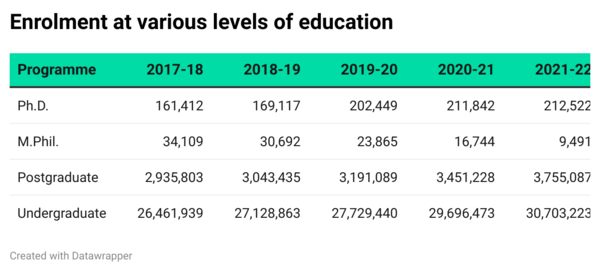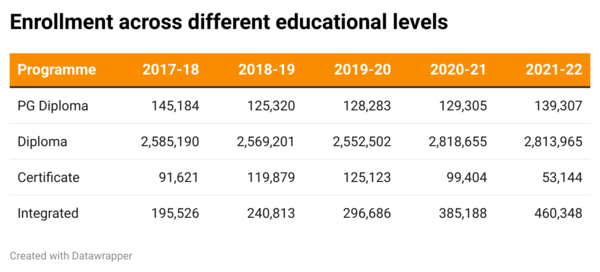Welcome To Latest IND >> Fastest World News
Higher education is crucial for a nation’s future, influencing its development, progress, and global standing. It drives economic growth, fosters innovation, and enhances social mobility, ultimately determining a country’s position on the world stage. A robust higher education system relies on academic rigor, accessibility, inclusivity, and financial stability.
Despite facing criticism for inefficiencies that contribute to a significant student exodus abroad, recent insights from the Deloitte and Confederation of Indian Industry (CII) report, Annual Status of Higher Education (ASHE) 2024, offer a more optimistic perspective. The findings of the report reveal that there has been a notable increase in Gross Enrolment Ratio (GER), indicating broader access to higher education. The Gender Parity Index (GPI) has also improved, with women’s enrolment surpassing men’s in recent years—a significant step towards gender equality. Additionally, there is a marked rise in PhD and postgraduate enrolments, reflecting a growing ambition among Indian students. This report highlights the progress made across various parameters of the Indian education system, suggesting a positive trajectory for the future. Here is a look at how India’s higher education institutes (HEIs) fared in the key parameters such as number of colleges, GER, GPI, pupil-to-teacher ratio (PTR), and more over the last 5 years.
Number of colleges over the last 5 years
The number of colleges in India has shown a steady increase over the past five years, with a slight dip in 2021-22. From 39,050 colleges in 2017-18, the total rose to 43,796 in 2020-21, reflecting a significant expansion in higher education infrastructure. This increase can be attributed to the growing demand for higher education and the government’s efforts to expand the college network. However, in 2021-22, the number slightly decreased to 42,825 colleges, indicating a minor setback after a period of rapid growth. Despite this, the overall trend from 2017 to 2021 highlights substantial progress in the expansion of educational institutions, which is crucial for meeting the needs of India’s growing student population.
| Year | Number of Colleges |
| 2017-18 | 39,050 |
| 2018-19 | 39,931 |
| 2019-20 | 42,343 |
| 2020-21 | 43,796 |
| 2021-22 | 42,825 |
Gross Enrolment Ratio
The Gross Enrolment Ratio (GER) in India has demonstrated a consistent upward trajectory from 2017 to 2022, reflecting significant strides in expanding access to higher education. According to the data, the national GER increased from 24.6% in 2017-18 to 28.4% in 2021-22, signaling a positive growth trend.
In terms of gender, female enrolment has shown notable improvement. In 2017-18, the GER for females stood at 24.6%, slightly higher than their male counterparts at 24.5%. However, by 2021-22, this gap had slightly widened, with female enrolment reaching 28.5%, compared to 28.3% for males. The most significant growth occurred between 2019-20 and 2020-21, when the GER surged from 25.6% to 27.3%, further underscoring the expanding reach of higher education.
This upward shift in GER, particularly in female participation, highlights the success of ongoing reforms and policies aimed at increasing educational access and gender parity in India. The data emphasizes the growing inclusivity of the higher education system, marking a promising trend toward greater educational equity.
| Year | Total GER | Male GER | Female GER |
| 2017-18 | 24.6 | 24.5 | 24.6 |
| 2018-19 | 24.9 | 24.4 | 25.5 |
| 2019-20 | 25.6 | 24.8 | 26.4 |
| 2020-21 | 27.3 | 26.7 | 27.9 |
| 2021-22 | 28.4 | 28.3 | 28.5 |
Gender Parity in India
The Gender Parity Index (GPI) in higher education showed notable fluctuations from 2017 to 2022. In 2017-18, the GPI was 1.01, indicating near gender parity. However, from 2018 to 2020, there was a steady increase, with the GPI rising to 1.06 in 2019-20. This signified a higher enrollment rate of females compared to males. The GPI then dropped back to 1.05 in 2020-21, maintaining a stable trend of higher female participation. By 2021-22, the GPI returned to 1.01, indicating a balancing of male and female enrollment rates once again. These trends reflect a temporary surge in female participation, followed by a return to equilibrium.
Pupil-to-Teacher Ratio in India
The pupil-to-teacher ratio saw a gradual decline from 25 in 2017-18 to 23 in 2019-20, indicating a slight improvement in the number of teachers available per student. However, in 2020-21, the ratio temporarily rose to 24 before returning to 23 in 2021-22, suggesting that while there was a minor fluctuation, the overall trend during this period remained relatively stable. The consistency in the ratio over the last few years could point to efforts aimed at balancing teacher availability in relation to student numbers, though slight variations reflect ongoing challenges.
Enrolment at various levels of education
Enrolment trends in higher education have revealed significant shifts in programme preferences. Ph.D. enrolments increased consistently, rising from 161,412 in 2017-18 to 212,522 in 2021-22, demonstrating a growing interest in advanced research. Similarly, postgraduate enrolments grew from 2.94 million to 3.75 million, indicating a rising demand for higher qualifications. Undergraduate enrolments also saw a steady rise, from 26.46 million to 30.7 million, highlighting improved access to higher education across the nation.
Enrolments in PG Diploma, Diploma, and Integrated programmes have shown mixed trends between 2017 and 2022. PG Diploma enrolments fluctuated, while Diploma numbers remained steady, peaking in 2020-21. Certificate enrolments declined, and Integrated programme enrolments grew significantly, highlighting a rise in interest in multi-level courses combining undergraduate and postgraduate education.
Latest IND






